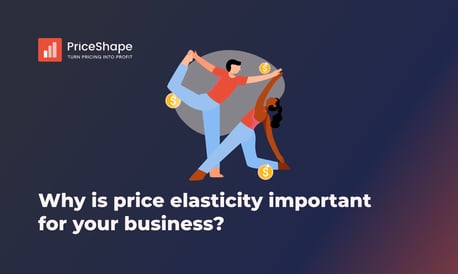3 rules to measure price elasticity and boost profit margins
Learn what price elasticity means for your business and how to use it to your advantage. Follow 3 rules to optimize pricing and maximize your profit.

Price elasticity of demand is one of the most critical metrics for retail businesses. Understanding the correlation between price changes and consumers’ reactions will help you optimize your price strategy and win customers’ loyalty.
“Profit for a company is like oxygen for a person. If you don’t have enough of it, you’re out of the game. But if you think your life is about breathing, you’re really missing something.”
Peter Drucker
What is price elasticity?
Price elasticity is a factor affecting how customers' demand for a given product changes in relation to its price. If your product is elastic, it’s sensitive to price changes, whereas if it is inelastic, it’s not sensitive to price changes.
Demand elasticity is the most well-known form of price elasticity, which means that the higher the product's price, the fewer consumers will buy it. Many economists call this type of price elasticity the most “safe” form of predicting consumer behavior.
The price elasticity differs from product type to product type and can differ for the same product at different consumption levels.
As a rule of thumb, most products' price elasticity is 1.0.
Everyday products that typically have few alternatives (here, we do not mean variants of products) have a lower elasticity; it can be basic food products. Products with many alternatives, or which are not essential, have a higher elasticity. Products considered luxury products, or where the purchase can be easily postponed, often have an elastic demand. However, more and more products are becoming more elastic as, over time, more alternatives appear on the market.
A good example of how price affects demand is the streaming service Netflix. Customers now appreciate more streaming services due to the coronavirus pandemic, where social distance and restrictions have characterized our daily lives. Customers' perceptions of prices and the value of streaming have changed significantly, as confirmed by a study by Simon-Kucher.
What customers care most about regarding Netflix is the breadth of content available, access to the latest releases, and the price, which is in the 4th place of priority. However, this is not enough to give concrete recommendations regarding the optimization of prices, as there is a lack of a more representative study. Still, it provides a good starting point for streaming providers, emphasizes Simon Kucher.
What’s the price elasticity formula?
Would you like to know if your customers will buy more when prices fall or buy less when prices rise? You can do this by calculating the elasticity of your products.
The basic calculation formula looks like this:

Nielsen, a business analyst organization, has recently calculated the price elasticity for 10,356 products to see where it makes sense to make price changes.
Almost half of the products they investigated had a price elasticity of 2 or more.
Economists use this formula to calculate consumer sensitivity to price changes to predict consumer behavior. The advantage is that it indicates a proportional change in demand and price. If a 1% drop in product price causes a 1% increase in demand for the product, demand elasticity equals 1.
Why is price elasticity necessary for your e-commerce?
Customers react to price changes. Therefore, it's alpha and omega that you know the price elasticity of your products and continuously follow up on whether the price elasticity changes to see if your products become more or less price sensitive. In addition, you probably know how difficult it can be to price the products in one's e-commerce. With an insight into how elastic or inelastic the goods are, you can strategically start working with pricing, thus increasing your earnings.
- For elastic items, you can reduce prices to increase sales volume and improve your price perception in the market. The price elasticity for such a product will be more than 1.
- For neutral products, the price elasticity is equal to 1, and the demand to price relationship is neutral.
- For inelastic products, you can increase the prices to increase the margin without affecting how many products are being sold. The price elasticity is less than one, and the demand for the product is inelastic.
Relevant PriceShape platform features: Advanced product management
How can you use price elasticity to get better sales results?
To use price elasticity as a helpful metric in your retail business, you need to learn how consumers react to price fluctuations. It's not easy, and there might be a lot to learn if you are just starting. We have made it easy for you with our market monitoring tool to manage your prices.
With a tool like PriceShape, you can look at your own and your competitors' sales trends, which can help you review the price elasticity of your products more easily and quickly. This valid data will enable you to make accurate decisions about prices and not rely on gut feelings. In addition, you can set up automatic pricing rules, so you save time on manual work with pricing.
In a price monitoring tool, you will get help for making intelligent decisions when testing the prices of your products and continuously optimizing the prices where you are competitive. It can be challenging to find the most optimal price for products with high elasticity, which means you will have to do more tests on these products. The opposite is true for products with inelastic prices.
Such knowledge can significantly help you to adjust supply and offer the correct prices to increase revenue.
Three ground rules for e-Commerce price elasticity
Here are three ground rules about price elasticity that you should be looking out for when working with pricing your products online:
- If your brand performs well, you would rather not lose the opportunity to exploit the potential your brand gives you. Customers like to pay more when they can see the value in your brand. When the customer perceives your brand as credible, there is less chance that you will lose demand if you increase the price. Finding the why behind your consumers' behavior is essential in your prediction of how customers will respond in the future to price changes. Observing and measuring purchasers’ behavior is the key to success.
- Supplement your qualitative research (consumers why) with quantitative testing such as the A/B test of prices. You will get better insights from doing an in-market A/B test. Today, in a digital context, it’s easy and inexpensive to do such a test. Start today with PriceShape and get a status report containing all your products and price history so you can pinpoint whose prices are the lowest or highest.
- Prices are "floating" and constantly changing, so you should make sure you are on-demand with how your prices develop to make the right decisions for your business. However, understanding the price elasticity of your product doesn’t tell you how to manage it. The goal for retailers is to stay relevant to consumers and differentiate from their competitors. To achieve this, you need to know the competitive landscape and adjust your price accordingly according to the level of value that you provide to your customers.
“81% of consumers are willing to pay for a better experience”
capgemini.com
After all, price elasticity is only one part of the data that helps you make better decisions about your prices.
You can’t look at it isolated, as the price is always placed in the context of the industry, its competitive structure, and in the context of consumers’ lives. Please also fell free to read our other blog about price elasticity: Why is price elasticity important for your business?
PriceShape can help you transform your work with pricing into an accessible and straightforward process as it relies on solid data. Get an insight into how PriceShape can help and get started today.


